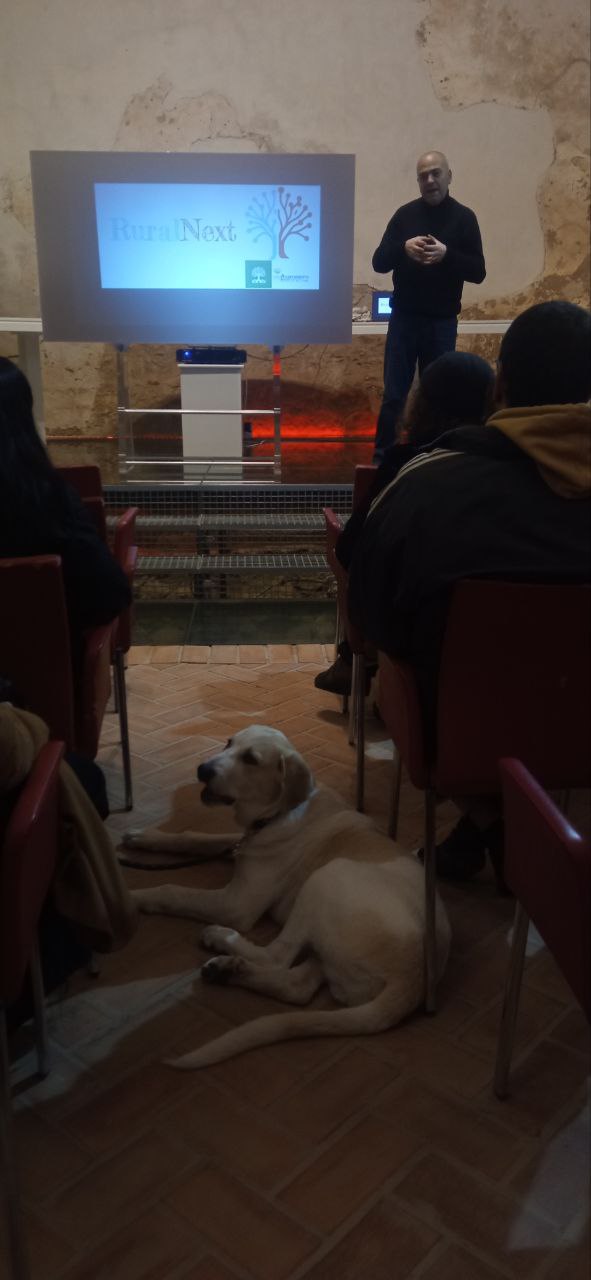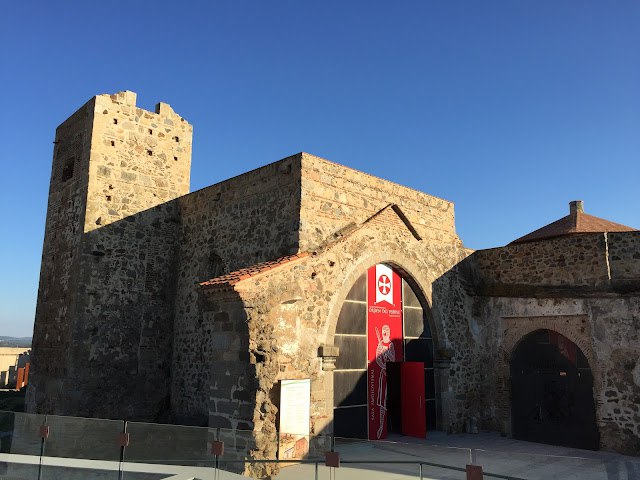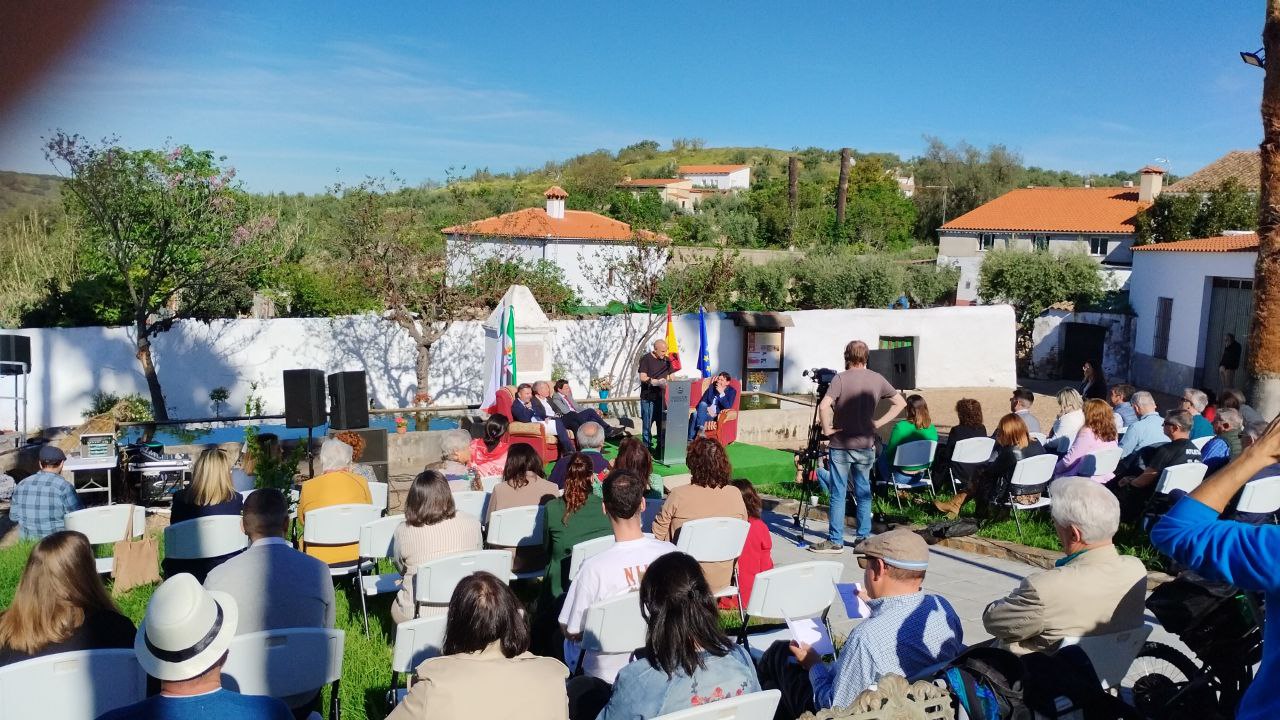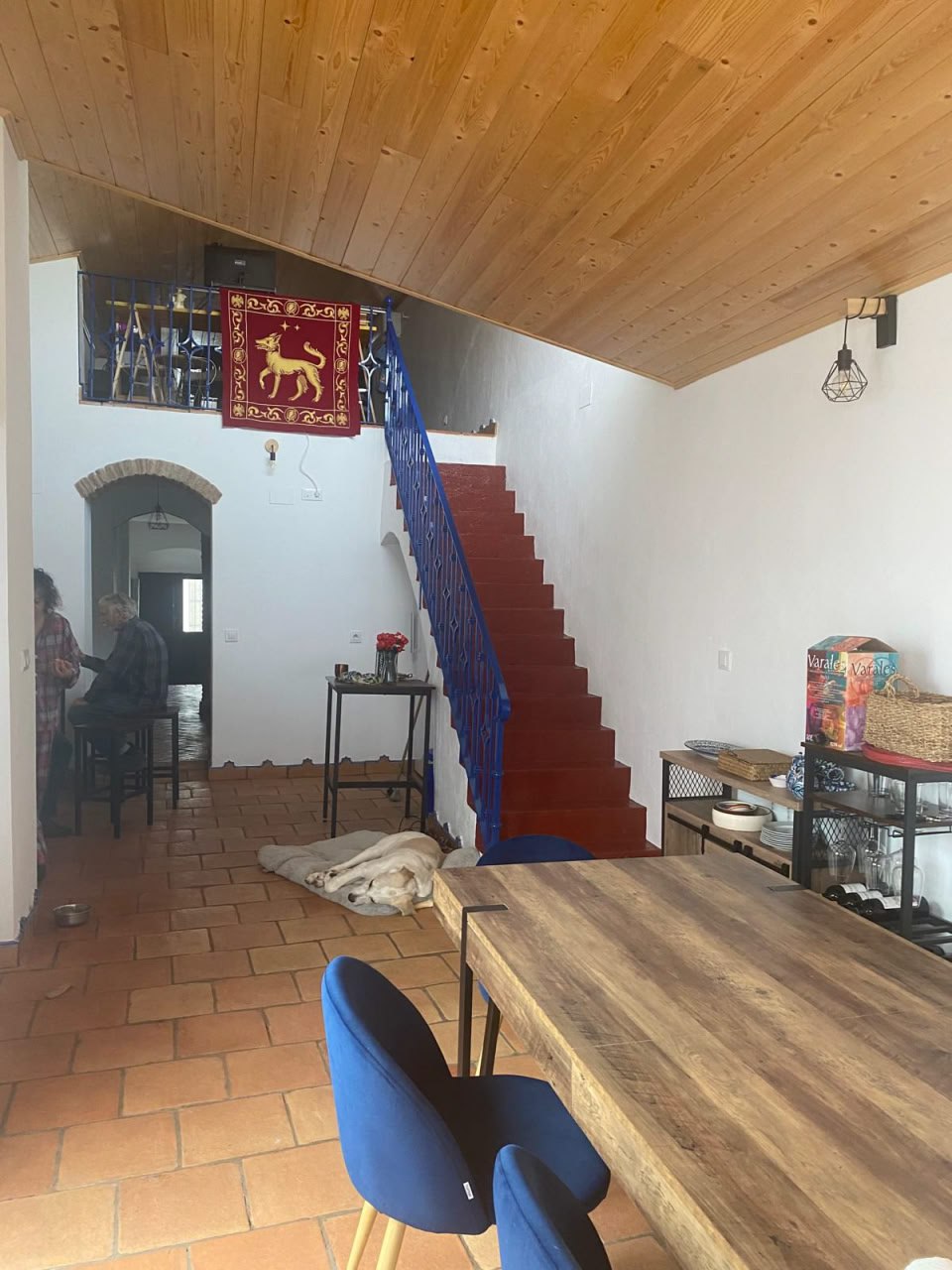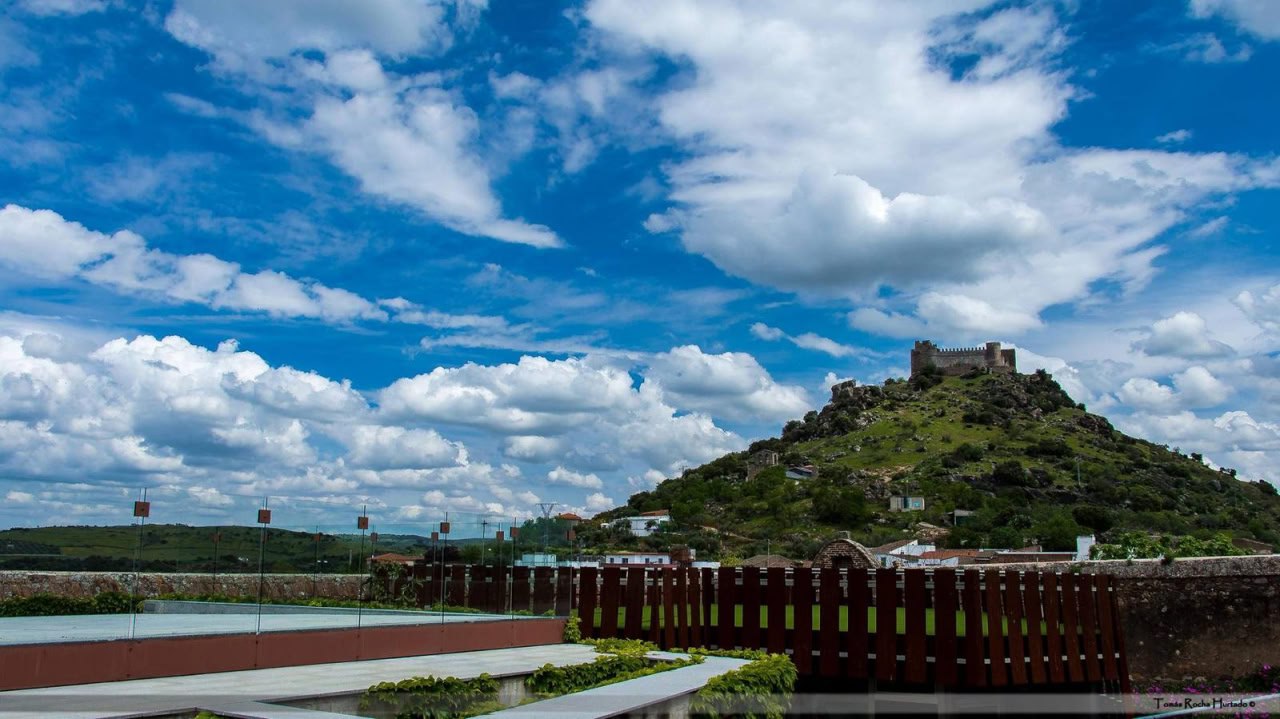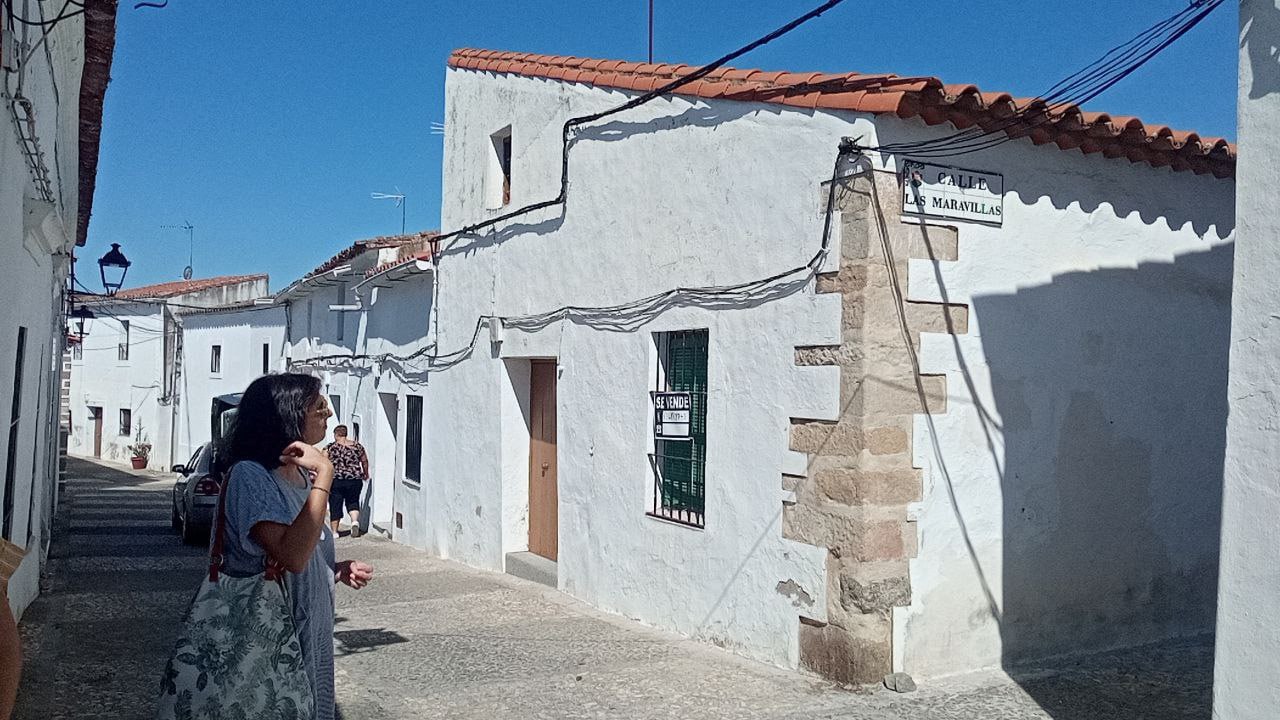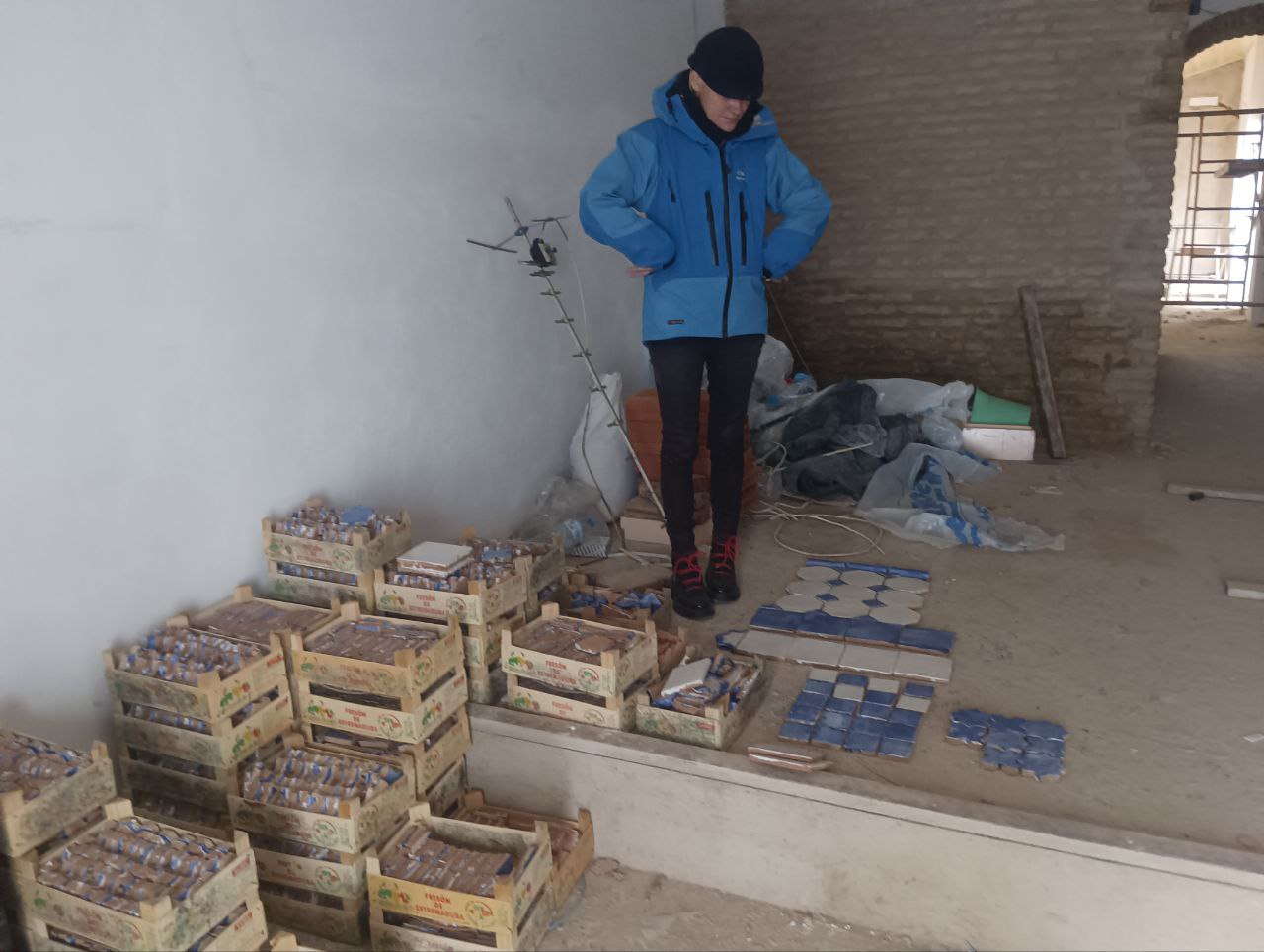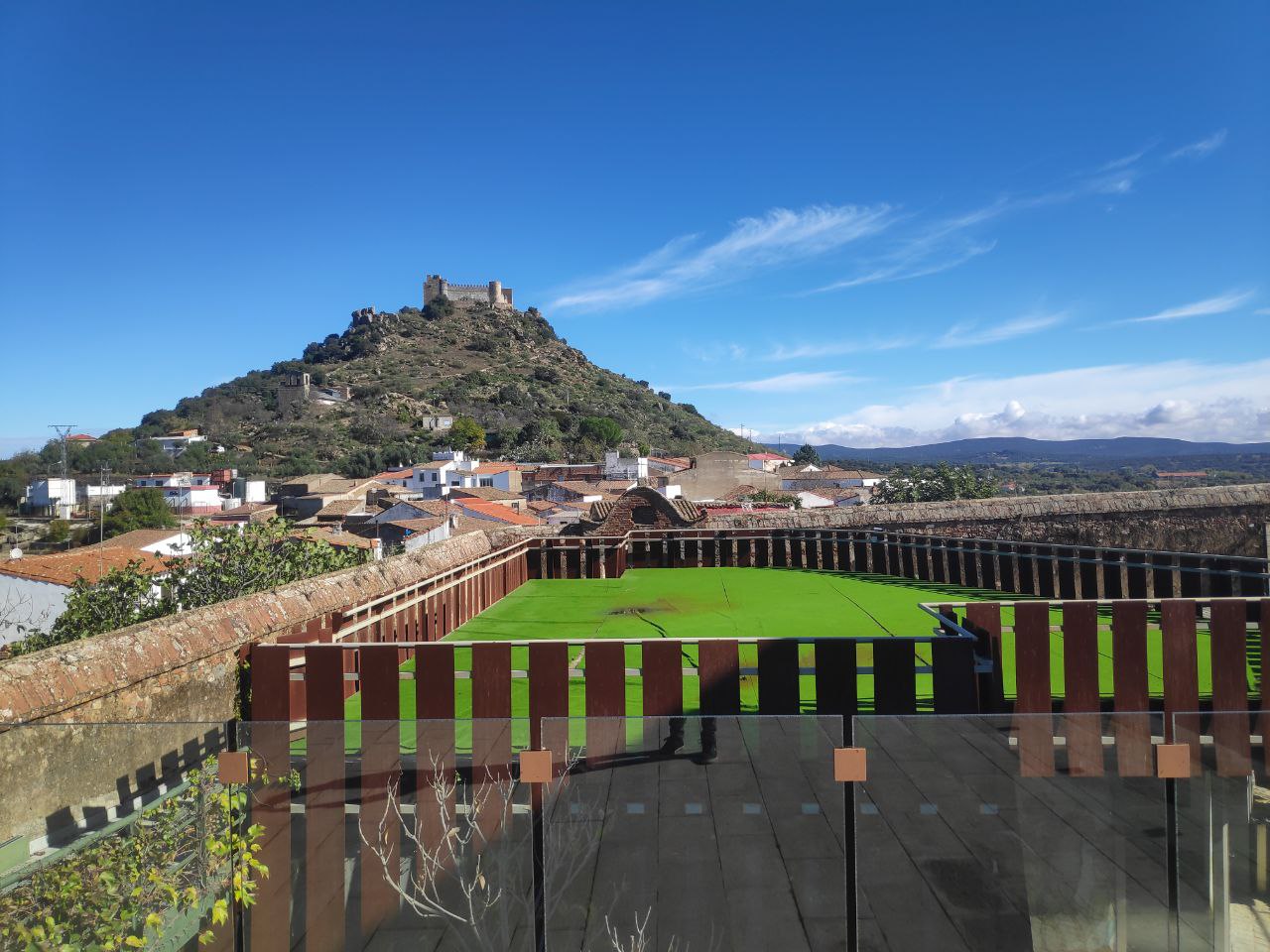RuralNEXT
RuralNEXT: Smart NEB Rural Revolution
Two small rural towns in Extremadura (Spain) with a rich historic heritage, located 8 km apart and united by a Mediterranean oak forest (Burguillos del Cerro & Valverde de Burguillos), combat depopulation through a groundbreaking initiative to continually develop and scale-up NEB-based solutions to challenges affecting rural towns. This project is the outcome of the impulse initiated by the 1st edition of the Rural NEB Fest, in which both towns played a key role
Spain
Calle San Juan, 43, 06370 Burguillos del Cerro, Badajoz
Early initiative
Yes
Yes
Yes
No
No
06022: Burguillos del Cerro (ES)
Two small rural towns with a rich heritage, located 8 km apart and united by a Mediterranean oak forest (Burguillos del Cerro & Valverde de Burguillos), combat depopulation through a groundbreaking initiative to continually develop and scale-up NEB-based solutions to challenges affecting rural towns
It is the outcome of the impulse initiated by Valverde in organizing the 1st Rural NEB Fest, a massive co-creation event in which local associations of all types debated the problems of a depopulating town with political representatives from the local to the European level
Main topics: local development, sustainability, digitalization, housing, job opportunities, and elderly care. It was crucial in initiating a conversation between stakeholders and in thus developing the work program that would blossom into RuralNEXT
Target Groups of RuralNEXT
• Local residents
• Vulnerable groups
• Young European talent
• Local enterprises
Key Objectives
1. Affordable Housing
Restoration of medieval homes using sustainable materials and traditional techniques. Social economy investors ensure affordability
2. Creation of an Economic & Social Council
To fuel social participation and co-design the future
3. International Rural NEB Innovation Hub
• Two annual tech projects to support vulnerable groups and boost rural productivity
• Green technologies for sustainable local production
• AI and augmented reality to enhance tourism
• Creation of high-quality jobs, education, and entrepreneurship opportunities
• Attraction of young EU talent
4. Celebrate the Rural NEB Fest on an annual basis
Expected Impact
• Increased availability of beautiful, affordable, and energy-efficient housing
• Ongoing tech and green innovation to boost rural development, entrepreneurship, employment opportunities, and sustainability
• Strengthened community ties
• Creation of rural European network committed to long-term NEB-based solutions
It is the outcome of the impulse initiated by Valverde in organizing the 1st Rural NEB Fest, a massive co-creation event in which local associations of all types debated the problems of a depopulating town with political representatives from the local to the European level
Main topics: local development, sustainability, digitalization, housing, job opportunities, and elderly care. It was crucial in initiating a conversation between stakeholders and in thus developing the work program that would blossom into RuralNEXT
Target Groups of RuralNEXT
• Local residents
• Vulnerable groups
• Young European talent
• Local enterprises
Key Objectives
1. Affordable Housing
Restoration of medieval homes using sustainable materials and traditional techniques. Social economy investors ensure affordability
2. Creation of an Economic & Social Council
To fuel social participation and co-design the future
3. International Rural NEB Innovation Hub
• Two annual tech projects to support vulnerable groups and boost rural productivity
• Green technologies for sustainable local production
• AI and augmented reality to enhance tourism
• Creation of high-quality jobs, education, and entrepreneurship opportunities
• Attraction of young EU talent
4. Celebrate the Rural NEB Fest on an annual basis
Expected Impact
• Increased availability of beautiful, affordable, and energy-efficient housing
• Ongoing tech and green innovation to boost rural development, entrepreneurship, employment opportunities, and sustainability
• Strengthened community ties
• Creation of rural European network committed to long-term NEB-based solutions
Community
Digitalization
Inclusion
Prosperity
Sustainability
1. Green Housing
Objective: Rehabilitation of historic residential buildings and make them more energy efficient
Action plan: Increase energy efficiency through insulation, the use of traditional materials and techniques, etc. Successfully completed a pilot project in Calle San Juan 12. Creation of the Economic & Social Council will promote citizen participation in co-designing the future
2. Environmental Data Collection
Objective: Develop green technologies in order to assist local rural production in making the green transition and mitigating the effects of climate change (drought)
Action plan: Organize internships for students and professionals to gather environmental data & conduct natural resource management studies that directly respond to the needs of farmers and local production. Green technologies are then developed in the Rural NEB Innovation Hub to be incorporated in local production. 4-5 students (University of Poitiers) will collect data and conduct a 3-month study on water management in both towns this year
3. Green Tourism
Objective: Promote green tourism
Action plan: Enhance the value of nature-based touristic activities that are especially respectful of the environment, such as bird watching, by incorporating digital technologies developed in the Rural NEB Innovation Hub
4. Rural NEB Fest
Objective: Find innovative and sustainable solutions for rural depopulation
Action plan: Organize festival yearly with local and international participants sharing ideas and solutions, showcasing successful NEB-based sustainable solutions.
Exemplary Aspects of the Initiative
Historic Heritage Integration: Combines heritage conservation with rehabilitation to create affordable and energy-efficient housing
Collaborative Approach: Engages diverse stakeholders and the community for holistic solutions
Innovation and Technology: Develops cutting-edge technologies for sustainability
Objective: Rehabilitation of historic residential buildings and make them more energy efficient
Action plan: Increase energy efficiency through insulation, the use of traditional materials and techniques, etc. Successfully completed a pilot project in Calle San Juan 12. Creation of the Economic & Social Council will promote citizen participation in co-designing the future
2. Environmental Data Collection
Objective: Develop green technologies in order to assist local rural production in making the green transition and mitigating the effects of climate change (drought)
Action plan: Organize internships for students and professionals to gather environmental data & conduct natural resource management studies that directly respond to the needs of farmers and local production. Green technologies are then developed in the Rural NEB Innovation Hub to be incorporated in local production. 4-5 students (University of Poitiers) will collect data and conduct a 3-month study on water management in both towns this year
3. Green Tourism
Objective: Promote green tourism
Action plan: Enhance the value of nature-based touristic activities that are especially respectful of the environment, such as bird watching, by incorporating digital technologies developed in the Rural NEB Innovation Hub
4. Rural NEB Fest
Objective: Find innovative and sustainable solutions for rural depopulation
Action plan: Organize festival yearly with local and international participants sharing ideas and solutions, showcasing successful NEB-based sustainable solutions.
Exemplary Aspects of the Initiative
Historic Heritage Integration: Combines heritage conservation with rehabilitation to create affordable and energy-efficient housing
Collaborative Approach: Engages diverse stakeholders and the community for holistic solutions
Innovation and Technology: Develops cutting-edge technologies for sustainability
Design and Aesthetics
Objective: Rehabilitate and enhance medieval-era housing
Action plan: Rehabilitate medieval-era housing while also restoring historic design and construction through traditional materials and techniques in order to enhance the liveability of the town and its aesthetic value and charm. Successfully completed a pilot project in "Calle San Juan 12" in which beautiful traditional tiling and terracotta flooring was incorporated
2. Positive Emotions
Objective: Foster a sense of belonging to the historic heritage of the town
Action plan: Active citizen participation in the Economic and Social Council of Burguillos that will be created will allow residents to experience pride, belonging, and connection to the towns' rich historical heritage, promoting positive emotions and community spirit
3. Cultural Benefits
Objective: Promote cultural enrichment
Action plan: The Rural NEB Innovation Hub promotes the enhancement of historic as well as natural tourism through the use of cutting-edge technologies. It also will organize conferences and participatory activities that educate participants about the historical, cultural, and technological heritage of the region, fostering a deeper appreciation of the towns' heritage. Concerts and cultural activities organized annually in the Rural NEB Fest and the Medieval Arts and Sciences Fall Festival also offer further opportunities for cultural enrichment
Exemplary Aspects of the Initiative
Enhancement of Historic Heritage: Seamlessly integrates modern sustainability practices with historic preservation, creating a visually appealing and culturally rich environment
Community Engagement: Actively involves the community in the process, fostering pride, belonging, and positive emotions among residents and visitors
Innovative Approach: Enhances historic heritage and promotes cultural enrichment through education and the incorporation of Arts, outdoor pedagogical activities and modern technologies
Objective: Rehabilitate and enhance medieval-era housing
Action plan: Rehabilitate medieval-era housing while also restoring historic design and construction through traditional materials and techniques in order to enhance the liveability of the town and its aesthetic value and charm. Successfully completed a pilot project in "Calle San Juan 12" in which beautiful traditional tiling and terracotta flooring was incorporated
2. Positive Emotions
Objective: Foster a sense of belonging to the historic heritage of the town
Action plan: Active citizen participation in the Economic and Social Council of Burguillos that will be created will allow residents to experience pride, belonging, and connection to the towns' rich historical heritage, promoting positive emotions and community spirit
3. Cultural Benefits
Objective: Promote cultural enrichment
Action plan: The Rural NEB Innovation Hub promotes the enhancement of historic as well as natural tourism through the use of cutting-edge technologies. It also will organize conferences and participatory activities that educate participants about the historical, cultural, and technological heritage of the region, fostering a deeper appreciation of the towns' heritage. Concerts and cultural activities organized annually in the Rural NEB Fest and the Medieval Arts and Sciences Fall Festival also offer further opportunities for cultural enrichment
Exemplary Aspects of the Initiative
Enhancement of Historic Heritage: Seamlessly integrates modern sustainability practices with historic preservation, creating a visually appealing and culturally rich environment
Community Engagement: Actively involves the community in the process, fostering pride, belonging, and positive emotions among residents and visitors
Innovative Approach: Enhances historic heritage and promotes cultural enrichment through education and the incorporation of Arts, outdoor pedagogical activities and modern technologies
1. Accessibility and Affordability
Objective: Ensure that housing is accessible and affordable for all residents and newcomers
Action plan: Rehabilitate medieval-era housing in order to make it accessible for people with disabilities. Ensure the creation of affordable housing solutions and models by involving the participation of Social Economy investors. Successfully completed a pilot project in "Calle San Juan 12" in which a workers' cooperative rehabilitated and invested in a XIIIth century home.
2. Inclusive Governance
Objective: Foster active citizen participation and inclusive decision-making processes
Action plan: The creation of the Economic and Social Council will promote active citizen participation in revitalizing the town's historic center, ensuring that diverse voices are heard and included in the decision-making process. The annual co-organization of the Rural NEB Fest also promotes the active participation of citizens in developing sustainable solutions to rural depopulation
3. Design for All
Objective: Promote social inclusion
Action plan: The initiative incorporates Design for All principles in the rehabilitation of housing and the development of technological projects. Furthermore, on an annual basis the Rural NEB Innovation Hub will develop projects to improve the quality of life of vulnerable populations, such as the elderly and people with disabilities, in rural areas
Exemplary Aspects of the Initiative
Holistic Approach to Inclusion: By addressing accessibility, affordability, governance, design, and societal models, RuralNEXT ensures a comprehensive and inclusive approach to community development
Community Engagement: Active involvement of residents through the Economic and Social Council and the Rural NEB Fest will foster a sense of ownership and inclusivity.
Sustainable Development: The focus on community participation and technological innovation promotes long-term inclusion and societal well-being
Objective: Ensure that housing is accessible and affordable for all residents and newcomers
Action plan: Rehabilitate medieval-era housing in order to make it accessible for people with disabilities. Ensure the creation of affordable housing solutions and models by involving the participation of Social Economy investors. Successfully completed a pilot project in "Calle San Juan 12" in which a workers' cooperative rehabilitated and invested in a XIIIth century home.
2. Inclusive Governance
Objective: Foster active citizen participation and inclusive decision-making processes
Action plan: The creation of the Economic and Social Council will promote active citizen participation in revitalizing the town's historic center, ensuring that diverse voices are heard and included in the decision-making process. The annual co-organization of the Rural NEB Fest also promotes the active participation of citizens in developing sustainable solutions to rural depopulation
3. Design for All
Objective: Promote social inclusion
Action plan: The initiative incorporates Design for All principles in the rehabilitation of housing and the development of technological projects. Furthermore, on an annual basis the Rural NEB Innovation Hub will develop projects to improve the quality of life of vulnerable populations, such as the elderly and people with disabilities, in rural areas
Exemplary Aspects of the Initiative
Holistic Approach to Inclusion: By addressing accessibility, affordability, governance, design, and societal models, RuralNEXT ensures a comprehensive and inclusive approach to community development
Community Engagement: Active involvement of residents through the Economic and Social Council and the Rural NEB Fest will foster a sense of ownership and inclusivity.
Sustainable Development: The focus on community participation and technological innovation promotes long-term inclusion and societal well-being
1. Economic & Social Council:
Beneficiaries: Local citizens, businesses, associations
Impact: Will empower citizens to have a say in revitalizing the town, leading to more effective and sustainable outcomes
2. Annual Open Source Technological Projects:
Beneficiaries: Vulnerable populations and enterprises in rural areas
Impact: On the basis of a participatory social process involving the entire town, cooperatives whose work is centered on developing open-source software will develop in the Rural NEB Innovation Hub two software and AI projects per year:
• one dedicated to improve the productivity of rural businesses
• the other to improve the quality of life of vulnerable populations in rural areas, such as the elderly and people with disabilities
3. Development of Green Technologies:
Beneficiaries: Local farmers and producers + young European professionals
Impact: Young European professionals and students will measure the management of natural resources in order develop green technologies. They will maintain regular communication with local farmers and producers to ensure that their studies align with the community's needs. This approach guarantees that the technologies developed are seamlessly integrated into local production
4. Workshops and Training Programs:
Beneficiaries: Residents and local businesses
Impact: Workshops and training programs that will be offered by the NEB Hub enhance digital skills and knowledge, fostering social entrepreneurship, high-quality employment opportunities, and economic development
5. Rural NEB Fest:
Beneficiaries: Local and international participants, including residents, municipalities, artists, cooperatives, and NGOs
Impact: Serves as a platform for sharing solutions to rural depopulation and environmental challenges. It promotes the development of NEB-based projects between different stakeholders, a sense of community, and the attractiveness of the region
Beneficiaries: Local citizens, businesses, associations
Impact: Will empower citizens to have a say in revitalizing the town, leading to more effective and sustainable outcomes
2. Annual Open Source Technological Projects:
Beneficiaries: Vulnerable populations and enterprises in rural areas
Impact: On the basis of a participatory social process involving the entire town, cooperatives whose work is centered on developing open-source software will develop in the Rural NEB Innovation Hub two software and AI projects per year:
• one dedicated to improve the productivity of rural businesses
• the other to improve the quality of life of vulnerable populations in rural areas, such as the elderly and people with disabilities
3. Development of Green Technologies:
Beneficiaries: Local farmers and producers + young European professionals
Impact: Young European professionals and students will measure the management of natural resources in order develop green technologies. They will maintain regular communication with local farmers and producers to ensure that their studies align with the community's needs. This approach guarantees that the technologies developed are seamlessly integrated into local production
4. Workshops and Training Programs:
Beneficiaries: Residents and local businesses
Impact: Workshops and training programs that will be offered by the NEB Hub enhance digital skills and knowledge, fostering social entrepreneurship, high-quality employment opportunities, and economic development
5. Rural NEB Fest:
Beneficiaries: Local and international participants, including residents, municipalities, artists, cooperatives, and NGOs
Impact: Serves as a platform for sharing solutions to rural depopulation and environmental challenges. It promotes the development of NEB-based projects between different stakeholders, a sense of community, and the attractiveness of the region
The project RuralNEXT builds on the efforts of Burguillos del Cerro in promoting historic rehabilitation and revitalization of its historic heritage, and on those of Valverde de Burguillos in promoting NEB values and the conservation of its cultural heritage.
Valverde de Burguillos, the only town with under 500 residents in the EuroACE region to have its own 2030 Urban Agenda, organized in April 2024 a cross-border satellite event of the NEB Fest, which will now be organized annually.
Key to the organization of this event were two NEB partners that work on the local level but that also on the regional, national, & European level:
-Compañía Maximalista S. Coop, nonprofit worker cooperative
-Fundación Repoblación, foundation dedicated to combatting rural depopulation
This cross-border satellite event, whose overwhelming success would get Valverde to win a Regional Architecture and Urbanism Prize and gain recognition from the Spanish section of the NEB movement, was the 1st edition of what would become the annual Rural NEB Fest.
For two days, citizens and representatives of local associations discussed and debated the problems of a depopulating town with academics, artists, NGOs and government representatives from all levels – from the local, regional, national level and European level.
The theme: Rural Repopulation & NEB. Participating in one of the interviews of this event were the mayors of Burguillos del Cerro and Valverde de Burguillos. The topic: The need to create European networks to Promote Sustainable Repopulation based on NEB principles.
Other topics included: access to housing, tourism, making historical heritage more accessible, giving new productive uses to protected historic heritage, economic diversification and dynamization through digitalization, etc.
RuralNEXT was born after a series of talks with both municipalities, the Compañía Maximalista S. Coop, Fundación Repoblación, local residents, enterprises, and NGOs
Valverde de Burguillos, the only town with under 500 residents in the EuroACE region to have its own 2030 Urban Agenda, organized in April 2024 a cross-border satellite event of the NEB Fest, which will now be organized annually.
Key to the organization of this event were two NEB partners that work on the local level but that also on the regional, national, & European level:
-Compañía Maximalista S. Coop, nonprofit worker cooperative
-Fundación Repoblación, foundation dedicated to combatting rural depopulation
This cross-border satellite event, whose overwhelming success would get Valverde to win a Regional Architecture and Urbanism Prize and gain recognition from the Spanish section of the NEB movement, was the 1st edition of what would become the annual Rural NEB Fest.
For two days, citizens and representatives of local associations discussed and debated the problems of a depopulating town with academics, artists, NGOs and government representatives from all levels – from the local, regional, national level and European level.
The theme: Rural Repopulation & NEB. Participating in one of the interviews of this event were the mayors of Burguillos del Cerro and Valverde de Burguillos. The topic: The need to create European networks to Promote Sustainable Repopulation based on NEB principles.
Other topics included: access to housing, tourism, making historical heritage more accessible, giving new productive uses to protected historic heritage, economic diversification and dynamization through digitalization, etc.
RuralNEXT was born after a series of talks with both municipalities, the Compañía Maximalista S. Coop, Fundación Repoblación, local residents, enterprises, and NGOs
1. Architects, Artisans, & Construction
Collaborate together to rehabilitate buildings, make them more energy-efficient, and enhance their traditional aesthetic. Social Economy investors collaborate to ensure the affordability of the rehabilitated buildings
Added Value: Affordable housing solutions that are beautiful, habitable, and sustainable
2. Social Economy & IT
Social enterprises focused on software and IA work with third sector organizations to meet the needs of vulnerable groups in rural areas. They also collaborate with local businesses in order to provide tech-based solutions to improve their productivity and environmental sustainability
Courses and consulting services for promoters of social enterprises and cooperatives offered in order to promote social economy initiatives
Added Value: Creation of tech solutions that address specific needs of vulnerable populations, enhancing their quality of life and promoting high-quality employment. Enhances local business efficiency and competitiveness through tech solutions and guidance
3. Historians, Scientists & IT
Historians collaborate in the development of technology used to enhance tourism based on historic heritage while scientists collaborate in that which is used to enhance nature-based tourism, such as bird watching
Added Value: Enhances the appeal of the town, attracting a more respectful and sustainable tourism
4. Local Producers and Metrology, Telecom, & IT young professionals
Young European students and professionals from the fields of metrology and telecom collaborate with farmers and local producers to gather and analyze environmental data. They then collaborate with software cooperatives and social enterprises to develop green resource management technologies
Added Value: Enhances local production and resilience against climate change droughts, benefiting both the community and the environment
Collaborate together to rehabilitate buildings, make them more energy-efficient, and enhance their traditional aesthetic. Social Economy investors collaborate to ensure the affordability of the rehabilitated buildings
Added Value: Affordable housing solutions that are beautiful, habitable, and sustainable
2. Social Economy & IT
Social enterprises focused on software and IA work with third sector organizations to meet the needs of vulnerable groups in rural areas. They also collaborate with local businesses in order to provide tech-based solutions to improve their productivity and environmental sustainability
Courses and consulting services for promoters of social enterprises and cooperatives offered in order to promote social economy initiatives
Added Value: Creation of tech solutions that address specific needs of vulnerable populations, enhancing their quality of life and promoting high-quality employment. Enhances local business efficiency and competitiveness through tech solutions and guidance
3. Historians, Scientists & IT
Historians collaborate in the development of technology used to enhance tourism based on historic heritage while scientists collaborate in that which is used to enhance nature-based tourism, such as bird watching
Added Value: Enhances the appeal of the town, attracting a more respectful and sustainable tourism
4. Local Producers and Metrology, Telecom, & IT young professionals
Young European students and professionals from the fields of metrology and telecom collaborate with farmers and local producers to gather and analyze environmental data. They then collaborate with software cooperatives and social enterprises to develop green resource management technologies
Added Value: Enhances local production and resilience against climate change droughts, benefiting both the community and the environment
1. Integration of Advanced Technology
RuralNEXT develops and makes use of advanced technologies such as artificial intelligence and augmented reality to achieve multiple objectives, ranging from meeting the needs of vulnerable groups in rural areas, to promoting tourism, local business productivity, and sustainable production. This not only revitalizes rural development in a panoramic way but also attracts young European talent interested in tech development in rural areas.
2. Multidisciplinary Approach
It combines knowledge from various disciplines and sectors, including Architecture, Construction, Masonry, History, Telecommunications, Metrology, Environmental Sciences, Agriculture, and IT. At the center of this collaboration is the role that social economy organizations play, which allows for a holistic and effective approach to rural challenges
3. Social Economy at the Center of Historic Heritage Conservation
Combines the rehabilitation of medieval-era homes using traditional yet energy-efficient materials and techniques with alternative housing models promoted by Social Economy investors. This method not only preserves historical heritage but also provides affordable and sustainable housing solutions.
4. Rural NEB Festival:
The creation of this Festival has marked a precedent in the Iberian NEB movement, in that it creates a previously inexistent space in the NEB movement for rural initiatives and joint European level collaboration.
RuralNEXT develops and makes use of advanced technologies such as artificial intelligence and augmented reality to achieve multiple objectives, ranging from meeting the needs of vulnerable groups in rural areas, to promoting tourism, local business productivity, and sustainable production. This not only revitalizes rural development in a panoramic way but also attracts young European talent interested in tech development in rural areas.
2. Multidisciplinary Approach
It combines knowledge from various disciplines and sectors, including Architecture, Construction, Masonry, History, Telecommunications, Metrology, Environmental Sciences, Agriculture, and IT. At the center of this collaboration is the role that social economy organizations play, which allows for a holistic and effective approach to rural challenges
3. Social Economy at the Center of Historic Heritage Conservation
Combines the rehabilitation of medieval-era homes using traditional yet energy-efficient materials and techniques with alternative housing models promoted by Social Economy investors. This method not only preserves historical heritage but also provides affordable and sustainable housing solutions.
4. Rural NEB Festival:
The creation of this Festival has marked a precedent in the Iberian NEB movement, in that it creates a previously inexistent space in the NEB movement for rural initiatives and joint European level collaboration.
The methodology used in RuralNEXT is rooted in the principles of Participatory Action Research (PAR), emphasizing active participation, collaboration, and empowerment of community members.
1. Collaborative Planning:
Community Engagement: Local residents and diverse stakeholders are actively involved in key components of the initiative.
• Rural NEB Festival : Allows local residents to propose the topics of the agenda, conduct public interviews with key government representatives and experts, and design the work agenda to promote rural repopulation and NEB values.
• Economic and Social Council : Allows residents to have a say in and make decisions on the revitalization of the historic center of Burguillos del Cerro.
• Meetings, surveys, and workshops. The Rural NEB Innovation Hub will regularly conduct meetings between stakeholders, such as farmers, the local association of business owners, NGOs, etc. It will also make use of surveys and regularly collect feedback from the digitalization workshops that it conducts. This ensures that the voices of all stakeholders are heard and their needs are prioritized in the planning process.
• Multidisciplinary Team: Community members and experts from various fields, such as architecture, construction, agriculture, economics, metrology, telecommunications, history, neuroscience, and IT, work together to develop holistic solutions. This collaboration fosters a sense of ownership and shared responsibility.
2. Reflective Practice:
Continuous Feedback: The methodology ensures that the projects receive feedback on a regular basis and adapt to the needs of beneficiaries.
Monitoring and Evaluation: The progress of various projects is continuously monitored, and adjustments are made as needed to ensure the best outcomes.
1. Collaborative Planning:
Community Engagement: Local residents and diverse stakeholders are actively involved in key components of the initiative.
• Rural NEB Festival : Allows local residents to propose the topics of the agenda, conduct public interviews with key government representatives and experts, and design the work agenda to promote rural repopulation and NEB values.
• Economic and Social Council : Allows residents to have a say in and make decisions on the revitalization of the historic center of Burguillos del Cerro.
• Meetings, surveys, and workshops. The Rural NEB Innovation Hub will regularly conduct meetings between stakeholders, such as farmers, the local association of business owners, NGOs, etc. It will also make use of surveys and regularly collect feedback from the digitalization workshops that it conducts. This ensures that the voices of all stakeholders are heard and their needs are prioritized in the planning process.
• Multidisciplinary Team: Community members and experts from various fields, such as architecture, construction, agriculture, economics, metrology, telecommunications, history, neuroscience, and IT, work together to develop holistic solutions. This collaboration fosters a sense of ownership and shared responsibility.
2. Reflective Practice:
Continuous Feedback: The methodology ensures that the projects receive feedback on a regular basis and adapt to the needs of beneficiaries.
Monitoring and Evaluation: The progress of various projects is continuously monitored, and adjustments are made as needed to ensure the best outcomes.
1. Community-Centric Approach: Involving local residents and stakeholders in planning and decision-making can be easily replicated in other areas and it is in fact the only way of developing solutions for rural areas capable of responding to their needs.
2. Multidisciplinary Collaboration: Bringing together experts from various fields ensures that diverse challenges can be tackled in a comprehensive manner, by leveraging a wide range of expertise and fostering innovative solutions.
3. Technological Integration: Software development and the use of advanced technologies like AI and augmented reality to promote productivity, tourism, and sustainability in rural areas is a strategy that is in line with the EU Smart Cities initiative. The difference is that the Rural NEB Innovation Hub adapts these objectives to the rural context while simultaneously promoting NEB values.
4. Affordable Housing: The promotion of social economy models in RuralNEXT, such as right-of-use housing cooperatives, is an example of an adaptation to the local context of models replicated in other European countries. Rehabilitating historic homes with traditional materials and techniques, while making them more energy-efficient, is a project that can be replicated in areas with a rich historic heritage.
6. Cultural and Educational Initiatives: Organizing cultural events, conferences, and training programs to promote community engagement and skill development can be applied in various settings. This enhances community identity, preserves cultural heritage, and equips residents with modern skills.
7. Rural NEB Festival and Activities: The concept of organizing an annual festival or an activity with rural NEB themes can be replicated in many other rural contexts as a way to promote NEB values in places that are not so easily reached by the NEB movement.
2. Multidisciplinary Collaboration: Bringing together experts from various fields ensures that diverse challenges can be tackled in a comprehensive manner, by leveraging a wide range of expertise and fostering innovative solutions.
3. Technological Integration: Software development and the use of advanced technologies like AI and augmented reality to promote productivity, tourism, and sustainability in rural areas is a strategy that is in line with the EU Smart Cities initiative. The difference is that the Rural NEB Innovation Hub adapts these objectives to the rural context while simultaneously promoting NEB values.
4. Affordable Housing: The promotion of social economy models in RuralNEXT, such as right-of-use housing cooperatives, is an example of an adaptation to the local context of models replicated in other European countries. Rehabilitating historic homes with traditional materials and techniques, while making them more energy-efficient, is a project that can be replicated in areas with a rich historic heritage.
6. Cultural and Educational Initiatives: Organizing cultural events, conferences, and training programs to promote community engagement and skill development can be applied in various settings. This enhances community identity, preserves cultural heritage, and equips residents with modern skills.
7. Rural NEB Festival and Activities: The concept of organizing an annual festival or an activity with rural NEB themes can be replicated in many other rural contexts as a way to promote NEB values in places that are not so easily reached by the NEB movement.
1. Green & Affordable Housing
Lack of affordable housing is a pressing issue, particularly in rural areas where historic buildings remain abandoned due to high restoration costs. RuralNEXT rehabilitates medieval homes using energy-efficient traditional materials, ensuring low environmental impact while providing affordable and comfortable living spaces.
2. Rural Depopulation
Depopulation leads to economic decline and cultural loss. RuralNEXT creates high-quality jobs, fosters entrepreneurship, and attracts young professionals by integrating sustainability-driven economic opportunities. Through the Rural NEB Innovation Hub, the initiative ensures green and digital job creation and long-term viability for rural economies.
3. Climate Change
With climate change increasing drought risks, RuralNEXT applies digital monitoring and smart irrigation to optimize water consumption. By integrating IoT and AI-based precision agriculture, local farmers will reduce waste and improve efficiency, making farming more resilient to climate challenges.
4. Social Inclusion
RuralNEXT ensures that digital transformation supports social sustainability by developing technologies that serve rural businesses, vulnerable populations, and local farmers. The Social Economy model ensures that technological solutions remain accessible and beneficial for all, avoiding exclusion of the elderly and marginalized groups.
5. Aging Population
Elderly require adapted infrastructure and services. RuralNEXT applies sustainable "Design for All" principles in housing renovations and public spaces to ensure accessibility, while also developing assistive technologies to improve the quality of life for elderly residents.
6. Youth Inclusion & Future Sustainability
Young people often leave rural areas due to limited opportunities. RuralNEXT actively engages young Europeans in sustainable entrepreneurship, digital training, and cultural projects, creating a long-term strategy for rural regeneration.
Lack of affordable housing is a pressing issue, particularly in rural areas where historic buildings remain abandoned due to high restoration costs. RuralNEXT rehabilitates medieval homes using energy-efficient traditional materials, ensuring low environmental impact while providing affordable and comfortable living spaces.
2. Rural Depopulation
Depopulation leads to economic decline and cultural loss. RuralNEXT creates high-quality jobs, fosters entrepreneurship, and attracts young professionals by integrating sustainability-driven economic opportunities. Through the Rural NEB Innovation Hub, the initiative ensures green and digital job creation and long-term viability for rural economies.
3. Climate Change
With climate change increasing drought risks, RuralNEXT applies digital monitoring and smart irrigation to optimize water consumption. By integrating IoT and AI-based precision agriculture, local farmers will reduce waste and improve efficiency, making farming more resilient to climate challenges.
4. Social Inclusion
RuralNEXT ensures that digital transformation supports social sustainability by developing technologies that serve rural businesses, vulnerable populations, and local farmers. The Social Economy model ensures that technological solutions remain accessible and beneficial for all, avoiding exclusion of the elderly and marginalized groups.
5. Aging Population
Elderly require adapted infrastructure and services. RuralNEXT applies sustainable "Design for All" principles in housing renovations and public spaces to ensure accessibility, while also developing assistive technologies to improve the quality of life for elderly residents.
6. Youth Inclusion & Future Sustainability
Young people often leave rural areas due to limited opportunities. RuralNEXT actively engages young Europeans in sustainable entrepreneurship, digital training, and cultural projects, creating a long-term strategy for rural regeneration.
1. Housing Rehabilitation:
Purchase and rehabilitate two empty residential buildings in the historic center of Burguillos del Cerro
2. Economic & Social Council:
Constitute it with NGOs and associations involved in rural social development in Burguillos del Cerro
3. Rural NEB Fest:
Organize the 2nd edition of the Rural NEB Fest in May 2025 in Valverde de Burguillos and Burguillos del Cerro
Present the national rural network promoting sustainable repopulation through digitalization and digital rights defense
4. NEB Hub:
Conduct a hybrid educational program for local businesses: “Simple Finances for projects with community impact.”
Adapt and retrofit the space for the Rural NEB Innovation Hub
Contact cooperatives and social enterprises focused on open-source software development; create alliances with key social economy organizations
Hire a young local resident to open the space daily
Officially present the Hub to Burguillos del Cerro's productive fabric
Organize a meeting between European cooperatives and social enterprises developing software for rural social development
5. Green Technology:
Welcome students from the University of Poitiers in “Telecommunications Engineering” and “Metrology” for final degree projects in both towns from April to June
NEB Values
Beautiful: Collaborate with architects, local construction professionals, skilled artisans, and historians to restore an aesthetic that reflects the historic patrimony of the town
Together: Set up participatory governmental structures for active citizen participation in every project aspect, including tech development and affordable housing solutions. Create alliances with diverse stakeholders at local, regional, national, and European levels
Sustainable: Apply rigorous energy-efficiency standards for housing rehabilitation. Collaborate with scientists and environmental experts to develop green technologies for local production and natural resource management
Purchase and rehabilitate two empty residential buildings in the historic center of Burguillos del Cerro
2. Economic & Social Council:
Constitute it with NGOs and associations involved in rural social development in Burguillos del Cerro
3. Rural NEB Fest:
Organize the 2nd edition of the Rural NEB Fest in May 2025 in Valverde de Burguillos and Burguillos del Cerro
Present the national rural network promoting sustainable repopulation through digitalization and digital rights defense
4. NEB Hub:
Conduct a hybrid educational program for local businesses: “Simple Finances for projects with community impact.”
Adapt and retrofit the space for the Rural NEB Innovation Hub
Contact cooperatives and social enterprises focused on open-source software development; create alliances with key social economy organizations
Hire a young local resident to open the space daily
Officially present the Hub to Burguillos del Cerro's productive fabric
Organize a meeting between European cooperatives and social enterprises developing software for rural social development
5. Green Technology:
Welcome students from the University of Poitiers in “Telecommunications Engineering” and “Metrology” for final degree projects in both towns from April to June
NEB Values
Beautiful: Collaborate with architects, local construction professionals, skilled artisans, and historians to restore an aesthetic that reflects the historic patrimony of the town
Together: Set up participatory governmental structures for active citizen participation in every project aspect, including tech development and affordable housing solutions. Create alliances with diverse stakeholders at local, regional, national, and European levels
Sustainable: Apply rigorous energy-efficiency standards for housing rehabilitation. Collaborate with scientists and environmental experts to develop green technologies for local production and natural resource management

